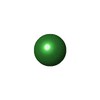+ Open data
Open data
- Basic information
Basic information
| Entry | Database: PDB / ID: 4k0o | |||||||||
|---|---|---|---|---|---|---|---|---|---|---|
| Title | F17b-G lectin domain with bound GlcNAc(beta1-3)Gal | |||||||||
 Components Components | F17b-G fimbrial adhesin | |||||||||
 Keywords Keywords | SUGAR BINDING PROTEIN / immunoglobulin-like fold /  lectin / carbohydrate receptor / acetylation of lysine side chain / cellular envelope lectin / carbohydrate receptor / acetylation of lysine side chain / cellular envelope | |||||||||
| Function / homology |  Function and homology information Function and homology informationadhesion of symbiont to host /  pilus / pilus /  carbohydrate binding / carbohydrate binding /  cell adhesion cell adhesionSimilarity search - Function | |||||||||
| Biological species |   Escherichia coli (E. coli) Escherichia coli (E. coli) | |||||||||
| Method |  X-RAY DIFFRACTION / X-RAY DIFFRACTION /  SYNCHROTRON / SYNCHROTRON /  MOLECULAR REPLACEMENT / Resolution: 2.15 Å MOLECULAR REPLACEMENT / Resolution: 2.15 Å | |||||||||
 Authors Authors | Buts, L. / Loris, R. / Bouckaert, J. / Moonens, K. | |||||||||
 Citation Citation |  Journal: Biology (Basel) / Year: 2013 Journal: Biology (Basel) / Year: 2013Title: Structural Sampling of Glycan Interaction Profiles Reveals Mucosal Receptors for Fimbrial Adhesins of Enterotoxigenic Escherichia coli Authors: Lonardi, E. / Moonens, K. / Buts, L. / de Boer, A.R. / Olsson, J.D. / Weiss, M.S. / Fabre, E. / Guerardel, Y. / Deelder, A.M. / Oscarson, S. / Wuhrer, M. / Bouckaert, J. | |||||||||
| History |
|
- Structure visualization
Structure visualization
| Structure viewer | Molecule:  Molmil Molmil Jmol/JSmol Jmol/JSmol |
|---|
- Downloads & links
Downloads & links
- Download
Download
| PDBx/mmCIF format |  4k0o.cif.gz 4k0o.cif.gz | 53.4 KB | Display |  PDBx/mmCIF format PDBx/mmCIF format |
|---|---|---|---|---|
| PDB format |  pdb4k0o.ent.gz pdb4k0o.ent.gz | 35.1 KB | Display |  PDB format PDB format |
| PDBx/mmJSON format |  4k0o.json.gz 4k0o.json.gz | Tree view |  PDBx/mmJSON format PDBx/mmJSON format | |
| Others |  Other downloads Other downloads |
-Validation report
| Arichive directory |  https://data.pdbj.org/pub/pdb/validation_reports/k0/4k0o https://data.pdbj.org/pub/pdb/validation_reports/k0/4k0o ftp://data.pdbj.org/pub/pdb/validation_reports/k0/4k0o ftp://data.pdbj.org/pub/pdb/validation_reports/k0/4k0o | HTTPS FTP |
|---|
-Related structure data
| Related structure data | 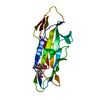 3f64C 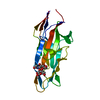 3f6jC 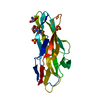 3ffoC  4bwoC  2bs8S S: Starting model for refinement C: citing same article ( |
|---|---|
| Similar structure data |
- Links
Links
- Assembly
Assembly
| Deposited unit | 
| ||||||||
|---|---|---|---|---|---|---|---|---|---|
| 1 |
| ||||||||
| Unit cell |
| ||||||||
| Components on special symmetry positions |
| ||||||||
| Details | biological unit is the same as asym. |
- Components
Components
| #1: Protein | Mass: 18937.900 Da / Num. of mol.: 1 / Fragment: UNP residues 23-198 Source method: isolated from a genetically manipulated source Source: (gene. exp.)   Escherichia coli (E. coli) / Gene: f17bG, F17G / Production host: Escherichia coli (E. coli) / Gene: f17bG, F17G / Production host:   Escherichia coli (E. coli) / References: UniProt: Q47200 Escherichia coli (E. coli) / References: UniProt: Q47200 | ||||
|---|---|---|---|---|---|
| #2: Polysaccharide | 2-acetamido-2-deoxy-beta-D-glucopyranose-(1-3)-methyl beta-D-galactopyranoside / Mass: 397.375 Da / Num. of mol.: 1 / Mass: 397.375 Da / Num. of mol.: 1Source method: isolated from a genetically manipulated source | ||||
| #3: Chemical |  Sulfate Sulfate#4: Chemical |  Nickel Nickel#5: Water | ChemComp-HOH / |  Water Water |
-Experimental details
-Experiment
| Experiment | Method:  X-RAY DIFFRACTION / Number of used crystals: 1 X-RAY DIFFRACTION / Number of used crystals: 1 |
|---|
- Sample preparation
Sample preparation
| Crystal | Density Matthews: 3.34 Å3/Da / Density % sol: 63.16 % / Mosaicity: 0.574 ° |
|---|---|
Crystal grow | Temperature: 293 K / Method: vapor diffusion, hanging drop / pH: 8.5 Details: 1.2M lithium sulphate, 10mM nickel chloride, 100mM TRIS, pH 8.5, VAPOR DIFFUSION, HANGING DROP, temperature 293K |
-Data collection
| Diffraction | Mean temperature: 100 K | |||||||||||||||||||||||||||||||||||||||||||||||||||||||||||||||||||||||||||||
|---|---|---|---|---|---|---|---|---|---|---|---|---|---|---|---|---|---|---|---|---|---|---|---|---|---|---|---|---|---|---|---|---|---|---|---|---|---|---|---|---|---|---|---|---|---|---|---|---|---|---|---|---|---|---|---|---|---|---|---|---|---|---|---|---|---|---|---|---|---|---|---|---|---|---|---|---|---|---|
| Diffraction source | Source:  SYNCHROTRON / Site: SYNCHROTRON / Site:  EMBL/DESY, HAMBURG EMBL/DESY, HAMBURG  / Beamline: X13 / Wavelength: 0.8128 Å / Beamline: X13 / Wavelength: 0.8128 Å | |||||||||||||||||||||||||||||||||||||||||||||||||||||||||||||||||||||||||||||
| Detector | Type: MAR CCD 165 mm / Detector: CCD / Date: Apr 13, 2005 / Details: MANUFACTURED BY MARUSA | |||||||||||||||||||||||||||||||||||||||||||||||||||||||||||||||||||||||||||||
| Radiation | Monochromator: DESY X13 / Protocol: SINGLE WAVELENGTH / Monochromatic (M) / Laue (L): M / Scattering type: x-ray | |||||||||||||||||||||||||||||||||||||||||||||||||||||||||||||||||||||||||||||
| Radiation wavelength | Wavelength : 0.8128 Å / Relative weight: 1 : 0.8128 Å / Relative weight: 1 | |||||||||||||||||||||||||||||||||||||||||||||||||||||||||||||||||||||||||||||
| Reflection twin | Operator: h,-h-k,-l / Fraction: 0.41 | |||||||||||||||||||||||||||||||||||||||||||||||||||||||||||||||||||||||||||||
| Reflection | Resolution: 2.15→99 Å / Num. all: 13775 / Num. obs: 13775 / % possible obs: 99.9 % / Observed criterion σ(F): 0 / Observed criterion σ(I): 0 / Redundancy: 24.8 % / Rmerge(I) obs: 0.069 / Χ2: 1.013 / Net I/σ(I): 21.5 | |||||||||||||||||||||||||||||||||||||||||||||||||||||||||||||||||||||||||||||
| Reflection shell |
|
- Processing
Processing
| Software |
| ||||||||||||||||||||||||||||||||||||||||||
|---|---|---|---|---|---|---|---|---|---|---|---|---|---|---|---|---|---|---|---|---|---|---|---|---|---|---|---|---|---|---|---|---|---|---|---|---|---|---|---|---|---|---|---|
| Refinement | Method to determine structure : :  MOLECULAR REPLACEMENT MOLECULAR REPLACEMENTStarting model: 2BS8 Resolution: 2.15→43.823 Å / Occupancy max: 1 / Occupancy min: 0.77 / FOM work R set: 0.8033 / Cross valid method: THROUGHOUT / σ(F): 1.32 / Phase error: 26.95 / Stereochemistry target values: TWIN_LSQ_F
| ||||||||||||||||||||||||||||||||||||||||||
| Solvent computation | Shrinkage radii: 0.9 Å / VDW probe radii: 1.11 Å / Solvent model: FLAT BULK SOLVENT MODEL | ||||||||||||||||||||||||||||||||||||||||||
| Displacement parameters | Biso max: 129.01 Å2 / Biso mean: 54.6589 Å2 / Biso min: 34.41 Å2 | ||||||||||||||||||||||||||||||||||||||||||
| Refinement step | Cycle: LAST / Resolution: 2.15→43.823 Å
| ||||||||||||||||||||||||||||||||||||||||||
| Refine LS restraints |
| ||||||||||||||||||||||||||||||||||||||||||
| LS refinement shell | Refine-ID: X-RAY DIFFRACTION / Total num. of bins used: 5
|
 Movie
Movie Controller
Controller



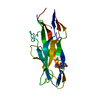






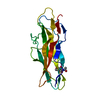

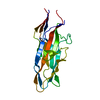
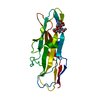

 PDBj
PDBj